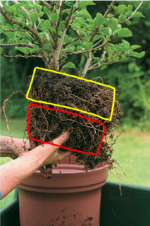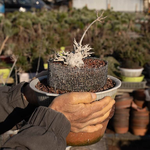ibakey
Mame
Hello folks.
I was listening on a podcast not too long ago between Jonas Dupuich and Andrew regarding growing out nursery/ garden centre or field grown material and Jonas mentioned something very interesting that I was thinking about all week.
He mentioned that he had a friend Tom who wondered if you can have a sacrifice branch, surely you can also have a sacrifice root.
So with materials that have deep roots either from the nursery pot or from the ground, instead of cutting off the bottom part of the roots which are usually strong, keep the bottom half of the root ball untouched with the soil for the moment and remove the first top half of soil. You can proceed to then arrange or prune the top half of the roots, before filling it with bonsai soil and potting it back into the original pot. Using this method allows the tree to not lose momentum (applies greatly to conifers) and helps to propel the growth of the tree, saving a few years of development. I think this is to develop the nebari while still allowing the tree to keep their strength from the field.
He did not elaborate further but I would think, you would slowly remove the bottom soil and replace it with bonsai soil too but keep the bottom roots and perhaps have a porous disk between the top and bottom half to prevent too much tangling between the roots.
I also just took a photo off the web to illustrate the example of removing soil from the yellow portion and keep the red intact, then root pruning the top part.

I am just getting a couple of trees in from the nursery in larger pots, so I am excited to try it.
But when would be the time to cut the sacrifice root off then? When you finally want to put it in a bonsai pot years later?
I was listening on a podcast not too long ago between Jonas Dupuich and Andrew regarding growing out nursery/ garden centre or field grown material and Jonas mentioned something very interesting that I was thinking about all week.
He mentioned that he had a friend Tom who wondered if you can have a sacrifice branch, surely you can also have a sacrifice root.
So with materials that have deep roots either from the nursery pot or from the ground, instead of cutting off the bottom part of the roots which are usually strong, keep the bottom half of the root ball untouched with the soil for the moment and remove the first top half of soil. You can proceed to then arrange or prune the top half of the roots, before filling it with bonsai soil and potting it back into the original pot. Using this method allows the tree to not lose momentum (applies greatly to conifers) and helps to propel the growth of the tree, saving a few years of development. I think this is to develop the nebari while still allowing the tree to keep their strength from the field.
He did not elaborate further but I would think, you would slowly remove the bottom soil and replace it with bonsai soil too but keep the bottom roots and perhaps have a porous disk between the top and bottom half to prevent too much tangling between the roots.
I also just took a photo off the web to illustrate the example of removing soil from the yellow portion and keep the red intact, then root pruning the top part.

I am just getting a couple of trees in from the nursery in larger pots, so I am excited to try it.
But when would be the time to cut the sacrifice root off then? When you finally want to put it in a bonsai pot years later?




